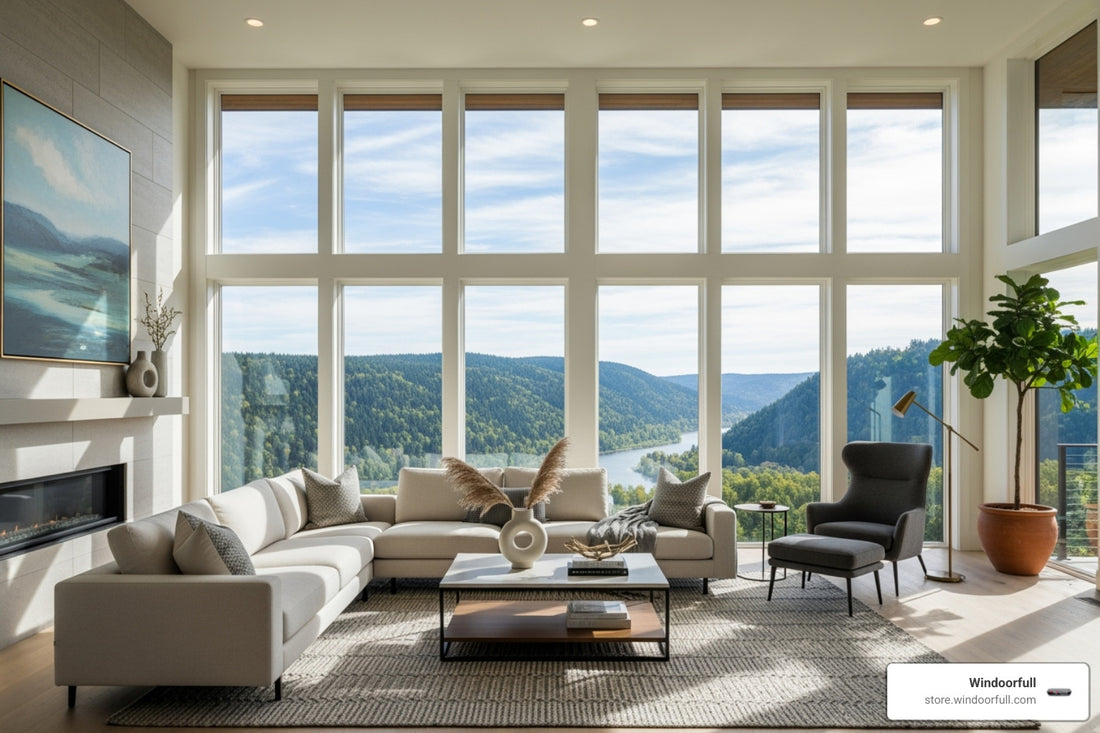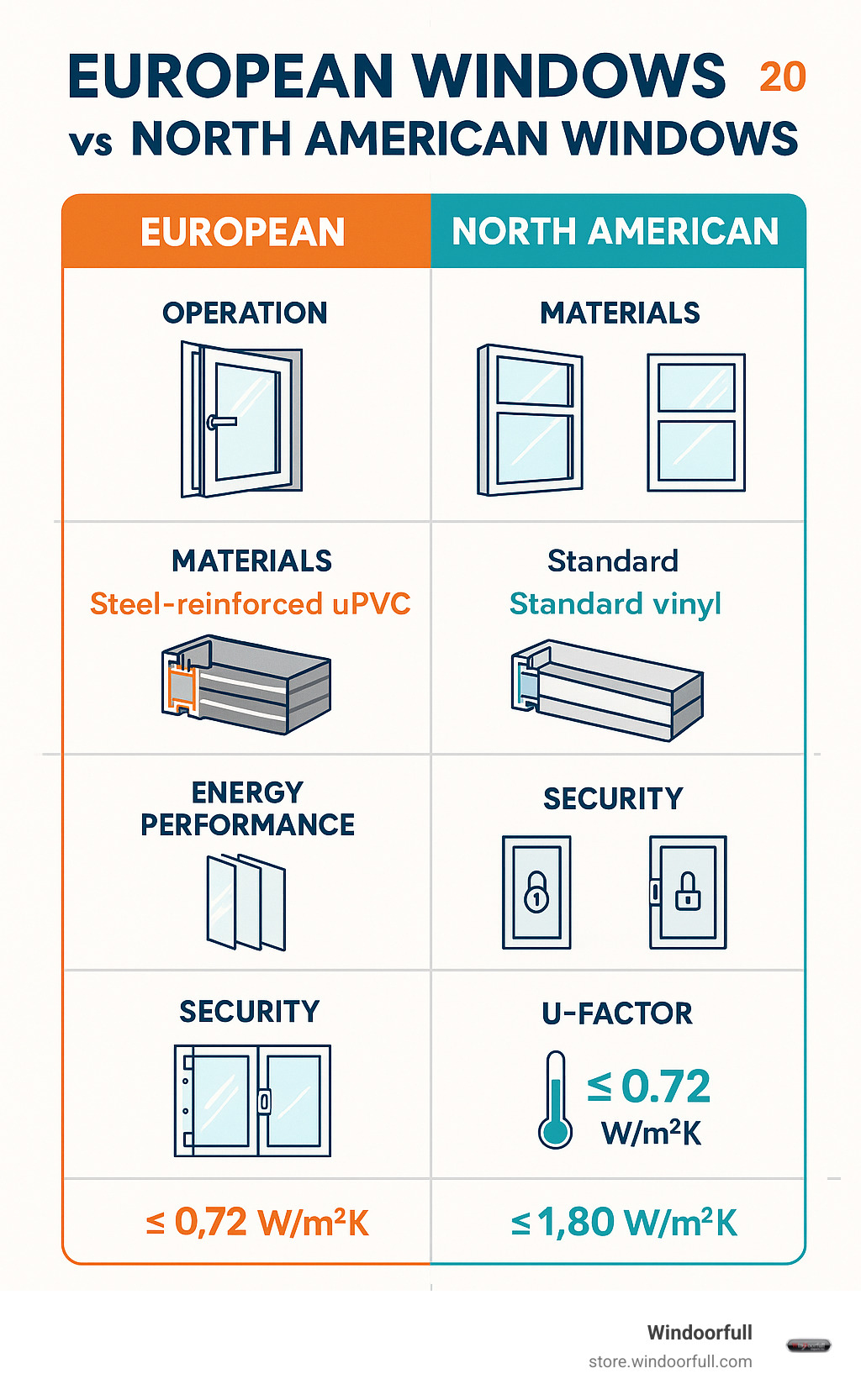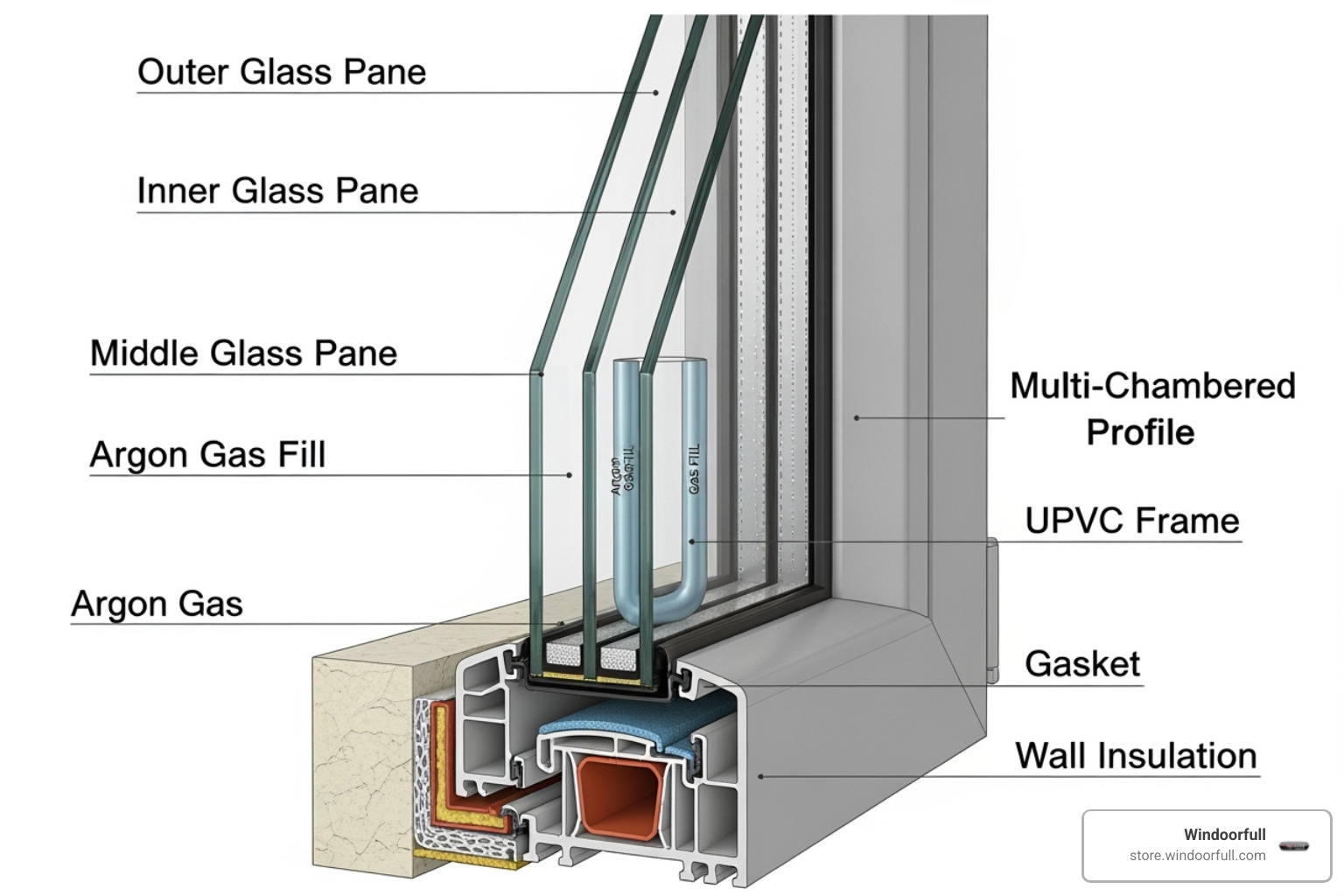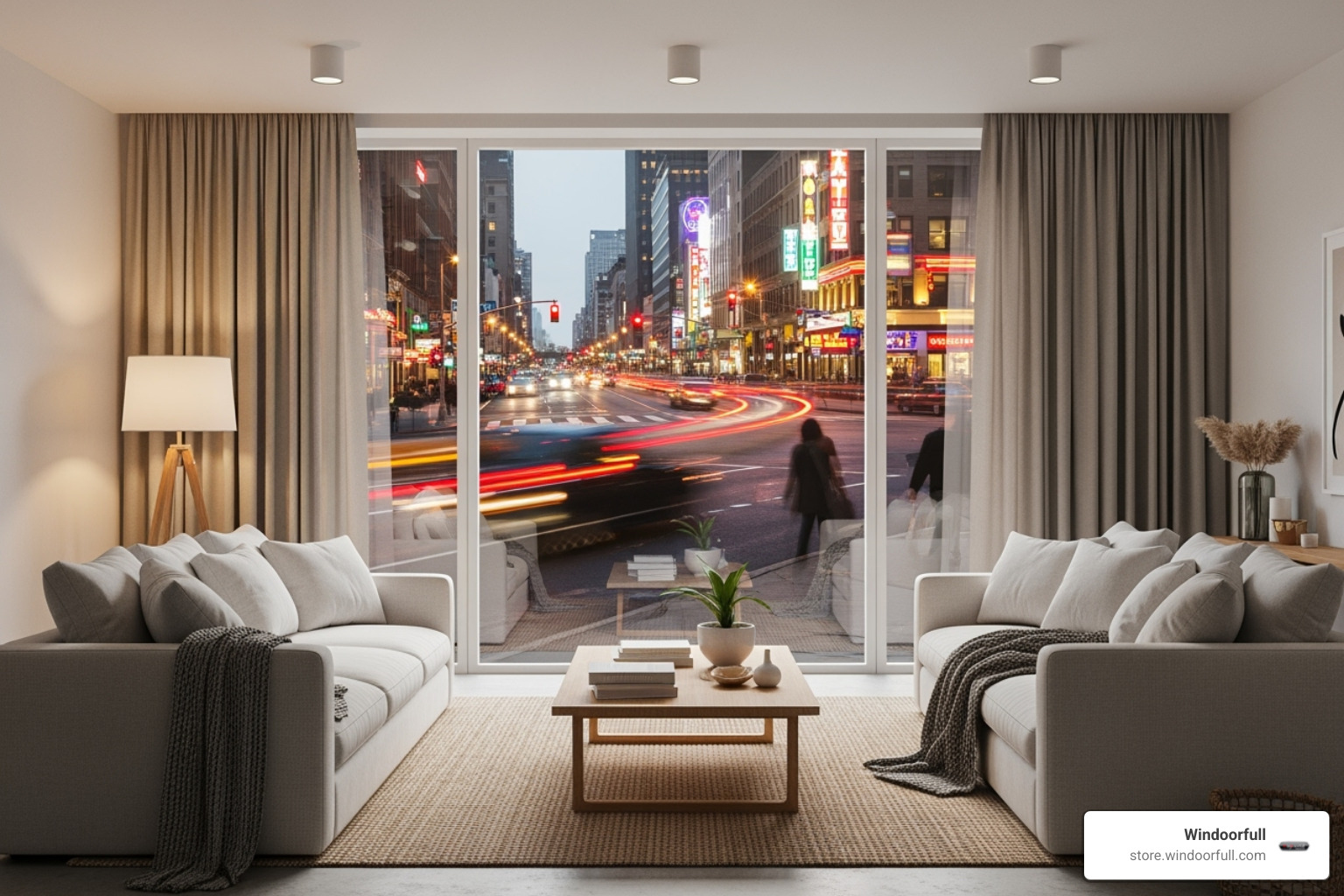
Everything You Need to Know About European Windows
Share
Why European Windows Are Revolutionizing North American Homes
European windows are advanced window systems that feature tilt-and-turn functionality, superior energy efficiency, and improved security compared to traditional North American windows. Here's what sets them apart:
Key Features of European Windows:
- Dual Operation: Tilt inward for ventilation or swing fully open like a door
- Triple Glazing: Standard feature for maximum insulation (Uw values up to 0.72 W/m²K)
- Multi-Point Locking: Improved security with RC2 burglary resistance standards
- Materials: Steel-reinforced uPVC, aluminum, or wood construction
- Energy Performance: Meet Passive House standards for ultra-low energy consumption
As one European manufacturer notes, "It is interesting and at the same time funny for many Europeans to see how non-European people, e.g. travelers from the USA and Canada, are fascinated by their windows." This fascination stems from the dramatic difference in functionality and performance.
While North American windows typically use double-pane glass and single-point locks, European windows incorporate triple-pane glazing, multiple compression seals, and sophisticated hardware systems. The result? Windows that can achieve thermal insulation up to 0.89 W/m²K and sound insulation up to 45dB - far superior to conventional alternatives.
The investment makes sense when you consider the long-term benefits: reduced energy bills, improved home security, and versatile ventilation options that work even during rain. For homeowners frustrated with drafty, inefficient windows that drive up heating costs, European windows offer a proven solution.
I'm Wojciech Jagla, and through Windoorfull Imports Inc., I specialize in distributing premium European windows featuring reliable German engineering and tilt-and-turn functionality. My experience helping North American homeowners upgrade to these high-performance systems has shown me how they transform both comfort and energy efficiency.

Know your european windows terms:
Key Differences: European Windows vs. North American Windows
When we talk about upgrading our homes, windows might seem like a straightforward choice. But once we dig into European windows, we quickly find that there are fundamental distinctions that go far beyond what meets the eye. Let's compare these two styles across several critical aspects, helping us understand the core differences.
Functionality and Design
One of the most striking differences we encounter is the functionality. North American windows often feature double-hung, sliding, or traditional casement operations. Double-hung windows slide up and down, and sliding windows move horizontally. While these are familiar, they can be limited in their ventilation options and challenging to clean from the inside, especially on upper floors.
European windows, on the other hand, are renowned for their innovative 'tilt and turn' mechanism. This ingenious design allows a single window sash to operate in two distinct ways:
- Tilt Inward: The top of the sash tilts inward, creating a small opening for draft-free ventilation. This is perfect for continuous air exchange without letting in rain or compromising security. We often find this feature incredibly convenient for maintaining air quality throughout the day.
- Swing Fully Open: With a simple turn of the handle, the entire sash swings inward, much like a door. This provides maximum ventilation, acts as an emergency egress, and makes cleaning the exterior glass a breeze – all from the safety and comfort of inside our home. This dual functionality truly improves our daily living experience.
Beyond operation, the design aesthetics also diverge. North American windows often have thicker frames and smaller glass panes, which can limit natural light. European windows typically boast sleek, minimalist frames with maximized glass areas. This design philosophy not only contributes to a modern, sophisticated look but also allows more natural light to flood our living spaces, creating a brighter, more inviting atmosphere. We believe this focus on clean lines and generous glazing is a significant appeal for contemporary architectural styles.
Materials and Construction
The materials and construction methods employed in European windows are another area where they truly shine, differentiating themselves from their North American counterparts. While North American windows commonly use vinyl, wood, or aluminum, European manufacturers often take a more engineered approach, focusing on performance and durability.
A popular choice for European windows is uPVC (Unplasticized Polyvinyl Chloride). Unlike standard vinyl, European uPVC profiles are often multi-chambered and reinforced with steel. This multi-chamber construction creates insulating air pockets within the frame, significantly enhancing thermal performance. The steel reinforcement provides exceptional structural stability, preventing warping and ensuring long-term durability. This robust construction means our windows will maintain their integrity and performance for years to come.
In addition to uPVC, we also see high-quality aluminum profiles, particularly for large-format windows and doors, known for their strength and slim sightlines. For those who appreciate the natural beauty of wood, European windows offer stunning wood options. And for the best of both worlds, Alu-Clad windows combine a warm, natural wood interior with a durable, low-maintenance aluminum exterior, providing excellent thermal performance and weather resistance. This thoughtful selection of materials ensures that our windows are not just beautiful, but also built to last and perform under various conditions.
Energy Efficiency and Thermal Performance
This is perhaps the most compelling area where European windows establish their dominance. While double-pane windows are the standard in North America, European windows often feature triple-glazing as a standard. This means three panes of glass with two insulating air or gas-filled chambers between them, providing a significantly higher level of thermal insulation.
But it doesn't stop there. These advanced glazing units are typically improved with:
- Low-E coatings: Microscopic, transparent coatings that reflect radiant heat, keeping our homes warmer in winter and cooler in summer.
- Argon gas fills: Inert gas, denser than air, filling the spaces between the panes to further reduce heat transfer. Krypton gas is also used for even higher performance in thinner units.
- Multiple compression seals: Unlike the single weatherstripping found on many North American windows, European designs incorporate two or three continuous seals around the sash, creating an airtight barrier against drafts and moisture.
The result of these combined technologies is superior thermal performance, measured by a very low U-value. For instance, our research shows that European windows can achieve Uw values (overall window U-value) as low as 0.72 W/m2K. To put that into perspective, a lower U-value means better insulation and less energy loss. This level of performance is crucial for achieving stringent energy efficiency standards, such as Passive House certification. The Defender 88PH+ windows and terrace swing doors, for example, are Passive House Institute (PHI) certified components, engineered for the world’s most rigorous energy-based building standard. We know that choosing windows with such high performance directly translates into significant savings on our heating and cooling bills.

Security and Durability
Beyond energy efficiency, we also care deeply about the security and durability of our homes. This is another area where European windows truly stand out, offering peace of mind that traditional North American options often can't match.
Many European windows incorporate robust multi-point locking systems. Instead of just one or two locking points, these systems engage several locking points around the entire perimeter of the sash when the handle is turned. This creates a much stronger, more secure bond between the sash and the frame, making forced entry significantly more difficult. We've seen options like RC 1 N, RC 2 N, and RC 2 security classes, indicating their resistance to various burglary attempts. This is a vital feature when we consider that in Canada, a burglary occurs every 4 minutes, and in the Greater Toronto Area, it happens every 3 minutes. Our products meet the stringent European RC2 burglary resistance standards, providing a much-needed layer of protection.
Furthermore, the materials themselves contribute to superior durability. The steel-reinforced uPVC frames, common in European windows, resist warping, cracking, and fading, ensuring long-term structural integrity. Reinforced glass options, such as laminated or tempered glass, add another layer of security, making the glass harder to break. This combination of advanced locking mechanisms and robust construction means our European windows are not just energy-efficient, but also incredibly secure and built to withstand the test of time.
The Core Advantages of High-Performance European Windows
Beyond the impressive technical specifications, European windows deliver real benefits that transform how we experience our homes. When you invest in these windows, you're not just buying a product – you're upgrading your entire living experience.
Superior Energy Efficiency and Cost Savings
The energy savings from European windows aren't just theoretical numbers on a spec sheet. They show up every month in lower utility bills and year-round comfort that you can actually feel.
Many European windows meet the rigorous Passive House certification standards. This isn't just another energy rating – it's the world's most demanding energy efficiency standard. Passive House buildings use up to 90% less energy for heating and cooling than conventional buildings. That's a game-changer for your monthly expenses.
Here's what this means in practical terms: your home stays comfortable with minimal heating and cooling. No more chilly drafts in winter or hot spots in summer. The stable indoor temperature means your HVAC system doesn't have to work overtime, leading to significant cost savings.
Our Avantgarde 7000 windows offer thermal insulation up to 0.89 W/m2K – that's exceptional performance that translates directly into energy savings. While the upfront investment in European windows is higher than standard options, the long-term savings quickly add up. Plus, you're reducing your carbon footprint, which feels good for both your wallet and the environment.
Improved Sound Insulation for a Quieter Home

Picture this: you live on a busy street, but inside your home, it's so quiet you can actually hear yourself think. That's the magic of European windows with their superior sound insulation.
The triple-glazing and multiple compression seals work together like a fortress against noise. Those extra glass panes and gas-filled chambers don't just keep heat in – they keep unwanted sounds out. The acoustic performance is measured by the Rw value, and European windows can achieve sound insulation with Rw up to 45dB. Our standard options typically range from Rw = 32 - 39 dB, depending on the glass unit you choose.
This level of sound control is perfect if you live near airports, highways, construction zones, or just have that one neighbor who loves their leaf blower at 7 AM. Whether you're working from home, trying to get the baby to sleep, or just want to enjoy a peaceful evening, the difference is remarkable.
Uncompromising Security and Peace of Mind
When it comes to protecting your family and belongings, European windows don't mess around. The security features built into these windows go far beyond what most North American windows offer.
The secret weapon is the multi-point locking system. Instead of a single lock that secures one point, these systems engage multiple locking points all around the window frame when you turn the handle. Think of it like having several deadbolts instead of just one – it creates an incredibly strong barrier that's extremely difficult to breach.
The steel-reinforced frames add another layer of protection. These aren't flimsy frames that can be easily damaged or warped. Combined with options for reinforced glass, you get windows that meet strict European RC2 burglary resistance standards.
The statistics are sobering: a burglary occurs every 4 minutes in Canada. With European windows, you're investing in real protection that gives you genuine peace of mind, especially when you're away from home.
Best Versatility and Customization
One of the most exciting aspects of European windows is how they adapt to your specific needs and style preferences. The variety of options means you can create exactly the look and functionality you want.
The opening types available give you incredible flexibility. The famous tilt & turn mechanism is just the beginning. Sliding windows work beautifully for patio doors and large openings. Folding windows create stunning indoor-outdoor connections by stacking completely out of the way. Picture windows maximize your views with minimal frame interference. Each style serves different purposes, so you can choose the perfect option for each area of your home.
The customization options are equally impressive. You can select from a wide RAL color palette to match your home's aesthetic perfectly. Whether you want classic white, bold black, or something that complements your siding, the color options are virtually limitless.
Hardware finishes let you coordinate with your interior design, from modern brushed steel to traditional brass. And because these windows can be manufactured in custom shapes and sizes, you're not limited by standard dimensions. Have an unusual opening or want to create an architectural statement? European windows can make it happen.
This level of personalization means your windows will perform exceptionally while looking exactly like you envisioned for your home.
A Practical Guide to Choosing and Installing European Windows
Making the decision to upgrade to European windows is exciting - you're about to transform your home's comfort, efficiency, and security. But like any major home improvement, it helps to know what you're getting into. Let me walk you through the practical side of choosing and installing these remarkable windows.
Understanding the Cost of European Windows
I'll be honest with you - European windows do require a higher upfront investment than standard North American windows. But here's the thing: this isn't really an expense, it's an investment that pays you back over time.
The price reflects what you're actually getting. These windows are engineered with steel-reinforced frames, triple-pane glazing with Low-E coatings and argon gas fills, and sophisticated multi-point locking systems. It's like comparing a basic economy car to a luxury vehicle - both will get you there, but the experience and long-term value are completely different.
The real magic happens in your monthly energy bills. With thermal performance reaching up to 0.89 W/m²K, European windows dramatically reduce heat loss in winter and heat gain in summer. Many homeowners find their heating and cooling costs drop significantly, which means the windows essentially start paying for themselves.
Several factors influence the final price. Material choice makes a big difference - uPVC is typically the most budget-friendly option, while wood and aluminum cost more. Glazing specifications matter too, though triple-glazing is standard. Size and configuration affect cost, with larger windows or complex shapes naturally costing more. Customization options like unique colors or special hardware can add to the price.
At Windoorfull, we work directly with European manufacturers to bring you authentic German engineering at prices that make sense for American homeowners. By cutting out the middleman, we can offer these premium windows without the premium markup you might expect.
Installation and Sourcing in North America
Here's something crucial to understand: the best European windows in the world won't perform properly if they're not installed correctly. These windows achieve their superior air and water tightness through precise installation techniques that differ from traditional North American methods.
You'll want to work with installers who understand European window systems. They need to know how to properly seal the frame to the wall, handle the shimming process, and ensure all the compression seals engage correctly. A qualified installer will make sure your windows are perfectly level and square, maximizing their thermal and acoustic performance.
When sourcing your windows, look for a supplier who offers more than just products. You want comprehensive support, including technical specifications, installation guidelines, and responsive customer service. We provide exactly this kind of support, plus the convenience of local pickup in Ozone Park, New York.
Don't forget to ask about warranties. Reputable European window suppliers typically offer robust warranties covering hardware, frames, and glass units for 15 years or more. This isn't just paperwork - it's their confidence in the product's durability speaking. We stand behind our windows with industry-leading warranty protection because we know they'll perform beautifully for decades.
Key Considerations for Your Project
Every home and every project is unique. When you're planning your European window upgrade, several key factors will help guide your decisions.

Project budget is obviously important, but remember to think long-term. The energy savings from European windows can offset the initial investment over time. Local climate needs matter tremendously - if you're dealing with harsh winters, scorching summers, or urban noise, the superior thermal performance (Uw values down to 0.72 W/m²K) and sound insulation (up to 45dB) become even more valuable.
Architectural style compatibility is another consideration. The clean, minimalist lines of European windows naturally complement modern and contemporary homes, but with various material and finish options, they work beautifully with traditional styles too. Think about your desired performance level - are you aiming for standard efficiency or something more ambitious like Passive House standards? European windows excel at meeting the most demanding energy requirements.
Finally, consider your security requirements. If peace of mind is important to you (and it should be, given that a burglary occurs every 4 minutes in Canada), the multi-point locking systems and robust construction of European windows offer a significant security upgrade.
By thinking through these factors carefully, you'll end up with windows that not only look fantastic but perform exactly how you need them to. Your home will be more comfortable, more secure, and more efficient for years to come.
Frequently Asked Questions about European Windows
Let's tackle some of the most common questions we hear about European windows. We want to make sure you have all the information you need to feel confident about upgrading your home!
What makes European uPVC windows a good choice?
Oh, where to begin! European uPVC windows are truly a fantastic choice for modern homes. They're incredibly durable and surprisingly low-maintenance, meaning less work for you in the long run. But their real superpower lies in their exceptional thermal and acoustic insulation. Imagine a home that stays perfectly cozy in winter and refreshingly cool in summer, all while keeping outside noise at bay.
This magic happens thanks to their clever design. Unlike simpler windows, European uPVC profiles are multi-chambered and often steel-reinforced. Think of these chambers like tiny insulating pockets within the frame. For example, some top-tier profiles like the Aluplast Intertec MD85 and Salamander BluEvolution 82 MD boast 6-chamber designs with 3 gaskets and steel reinforcement. This intricate structure creates those insulating air pockets that dramatically minimize heat transfer. The result? Lower energy bills and a wonderfully stable indoor climate. Plus, their robust, weather-resistant surfaces mean they'll keep looking great for years with very little fuss.
How do European windows contribute to Passive House standards?
If you're aiming for the pinnacle of energy efficiency in your home, then European windows are your best friend. Their entire design philosophy is built around performance. They come packed with features specifically engineered to meet the incredibly rigorous Passive House energy standard.
We're talking about things like triple-glazing (three panes of glass for maximum insulation!), advanced low-E coatings that reflect unwanted heat, multiple air seals to stop drafts dead in their tracks, and thermally broken frames that prevent heat from escaping through the frame itself. All these elements work together seamlessly to virtually eliminate heat loss and air leakage. It's this meticulous engineering, including advanced hardware and precise sealing systems, that creates an incredibly tight building envelope. This means your home needs very little energy for heating or cooling, helping you achieve those ultra-low energy consumption goals that Passive House certification demands. In fact, specific models like the Defender 88PH+ windows are even Passive House Institute (PHI) certified components!
Are European windows difficult to install?
This is a great question! While we wouldn't say European windows are "difficult" to install, they definitely require a different kind of precision. Think of it like this: to fully open up their incredible performance benefits – especially their superior air and water tightness – the installation needs to be spot-on.
That's why we always recommend working with installers who have specific experience with these systems. Unlike typical North American windows that might rely on nail fins for installation, many European windows are designed as replacement windows without nail fins. This means the installer needs a different, more careful approach to sealing and flashing to ensure a perfect, airtight fit. Proper measurement before installation, and meticulous adjustment afterward, are also crucial for the iconic tilt and turn mechanism to operate smoothly and for all those clever seals to engage correctly. A knowledgeable installer understands these nuances and will ensure your beautiful new windows perform exactly as they're designed to.
Conclusion
As we've explored, European windows truly represent a significant leap forward compared to standard North American options. They offer a fantastic blend of superior energy efficiency, robust security, lasting durability, and a sleek, modern design that can truly lift any home.
While you might notice a higher initial investment, think of it as planting a tree for your future. The long-term savings you'll see on your energy bills, combined with the undeniable increase in home comfort and overall value, make them a remarkably smart choice for any renovation or new build. Imagine less worry about drafts, lower heating and cooling costs, and a quieter, more secure living space.
From the ingenious 'tilt and turn' mechanism that gives you versatile ventilation and makes cleaning a breeze, to the robust multi-point locking systems that offer unparalleled peace of mind, and the advanced triple-glazing that provides exceptional thermal and acoustic insulation – European windows are carefully engineered to improve your everyday living experience. They're not just windows; they're an upgrade to your lifestyle.
For homeowners across the USA looking for authentic European engineering without the European price tag, Windoorfull is here to help. We provide high-quality uPVC tilt and turn windows and doors designed to meet the most demanding performance standards, all while keeping them accessible for the American market. We genuinely believe that choosing these high-performance windows isn't just about updating a part of your home; it's about changing your entire living environment into a more comfortable, secure, and energy-efficient sanctuary.
Ready to transform your home with windows that perform as beautifully as they look? Explore the smart choice for modern homes and see why tilt and turn windows belong in your USA home.
